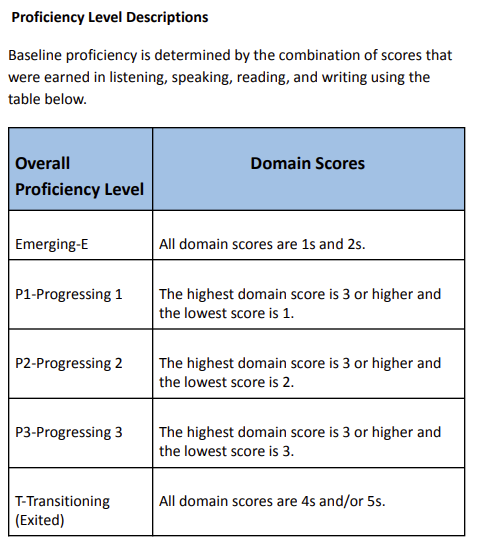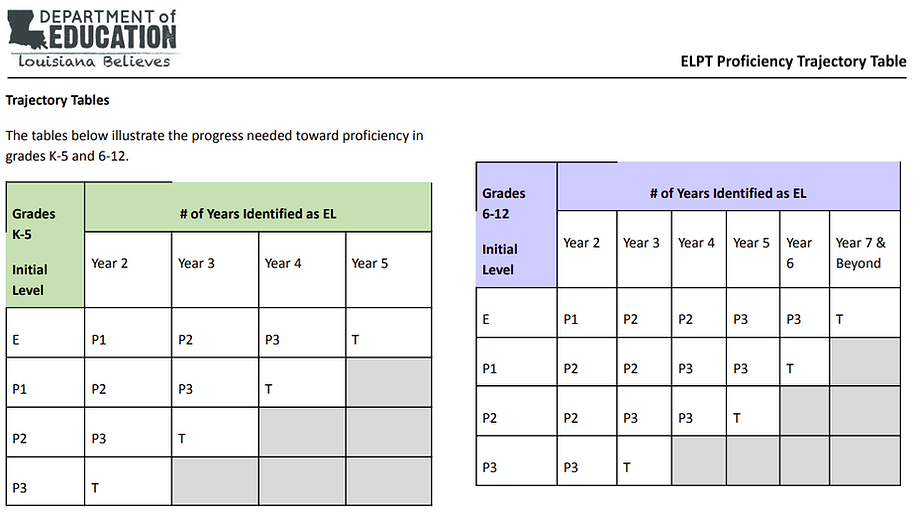What is the English Learner Acquisition (ELL) category on the Score Card?
Author - Morgan Cerniglia
December 19, 2024
This category will based on your English Learner's performance on the English Language Proficiency Test (ELPT), the annual state exam that assesses their progress towards becoming proficient in English. The number reported in this box will be the percentage of students who meet their target proficiency level. This language is important! In the previous years, schools have received 80 points for each student who grew at least one proficiency level from one year to the next. In other words, schools were rewarded for growing their students, even if they didn't make their target.
But now...schools will be losing that benefit. No longer will we receive points for growing a student toward proficiency, unless they meet their trajectory target. So how is the trajectory target determined?

When an English Learner joins a school in Louisiana, that student is screened using the English Language Proficiency Screener (ELPS). If the students scores less than proficient, then the student is enrolled in the school's English Learner Program, which typically includes a classroom or pull-out English Language Direct or English as a New Language (ENL./ESL) course. The testing window for the English Language Proficiency Test (ELPT) is mid-February to mid-March -- before the LEAP testing window opens.
When the new English Learner student takes the ELPT for the first time that is their baseline year, and they will not be included in the calculation of the ELL category on the score card.
After that initial or baseline year, students are expected to follow the trajectory table according to which grade they began their journey towards proficiency.
Figure 1: This chart is from the ELPT Proficiency Trajectory Table PDF posted on the LDOE website. (Last updated 2021)

Figure 2: This chart is from the ELPT Proficiency Trajectory Table PDF posted on the LDOE website. (Last updated 2021)
This table is best explained by example. Let's say we have a student--let's call her Maria-- who join us as a first grader. Maria tests less than proficient on the ELPS in October. She is enrolled in the English Learner Program and is classified as an English Learner. In February, she takes the first grade ELPT and she scores "E", which means emerging. Maria speaks very little English and has not developed grade level literacy skills in English. This score of "E" or emerging is her baseline year score. Each year, the trajectory will be based on the baseline year score and the current year of enrollment in the English Learner program.
"Each year, the trajectory will be based on the baseline year score."
Since Maria scored "E" in first grade, her trajectory for the following year will be "P1." If Maria scores on trajectory with a Progressing Level 1 (P1), then she will be included in the percentage of students who made their trajectory target. If Maria does scores Emerging (E) again, she will count in the negative of the percentage because she did not meet her target.
Let's say Maria is really struggling academically and socially and she does score Emerging (E) in second grade. The slate does NOT reset. In order for Maria to meet her trajectory goal and for the school to be rewarded points, she will have to score Progressing Level 2 (P2), even though that is now a growth of 2 years expected to be accomplished within one year. At this point, you might be thinking, "That's crazy! That's just not realistic expectations on a child adjusting to a whole new life in a new country." Well...if you're thinking that, you're not alone. Unfortunately, it gets worse....
Meet Ben. Ben is a 9th grade Vietnamese student who has been in the US in your school system since the 4th grade. Ben is a smart kid and his teachers know this, but he is really struggling with learning English. Even after being immersed in your school's English environment for 4 years and taking the ESL course, Ben is still scoring 1s and 2s on his ELPT, which results in a proficiency level of Emerging (E). Because Ben is in his 5th year, according to the LDOE trajectory table, he is expected to test proficient this year. That means the school will be punished for Ben's lack of proficiency every year starting this year until he tests proficient. It doesn't matter if you get an amazing new ESL teacher this year and Ben grows by 2 proficiency levels, the school's Score Card will still be negatively impacted...unless he tests proficient.
"Ben is supposed to be proficient this year. Ben grows two whole proficiency levels in one year form Emerging (E) to Progressing Level 2 (P2)! That's AMAZING! ....But...the school's score card will still be negatively impacted."
The school's Score Card will be negatively impacted every year the EL does not meet their trajectory target, even if they did not meet the trajectory target from the previous year. The bar continues to be pushed further away, even if they did not reach the bar last time. As you can imagine, an EL might start to get very discouraged very quickly if they are made aware of this target and pressure, which I've found most ELs are aware of their ELPT goals. Do your ELs NEED to know about the school's trajectory target for them? Not really. I would encourage my ESL specialists and teachers out there to continue to work with your students to set attainable and realistic goals for the annual ELPT, and keep the school's needs to yourself. Our students already have enough pressure on them to learn English AND learn all of their grade-level content. This accountability is probably better kept a secret from those students who are one or more years behind in their journey towards proficiency. Yes, the school's performance score is important, but so is the mental health of your students.
Will all schools with English Learners be impacted by this category on the new score card?
No! This is my only good piece of news (for some of you). The ELL category on the Score Card will only be applied to schools that have at least 15 ELs. This is a change from the previous system. Previously, you needed at least 10 students in a single grade within a school for the ELPT to make a large impact on the School Performance Score (SPS). Now it's just 15 in the school in total. Many public schools in Louisiana are gaining large numbers of ELs and are well over this threshold. That leaves a lot of buffer zone if a few students are far off their trajectory target. For the smaller, more rural areas of the state that have, for example, only 25 students in a given school, the percentage is impacted a lot more by those few students being off target.
